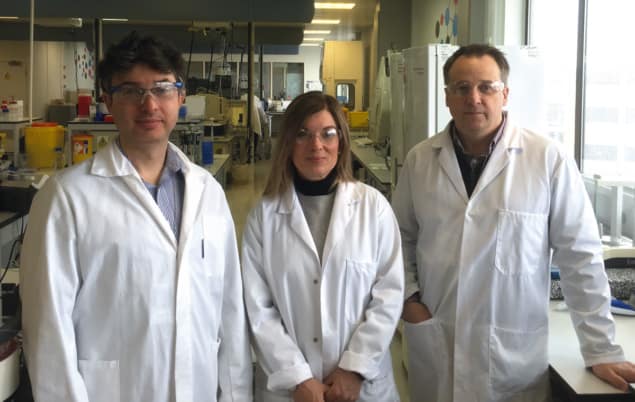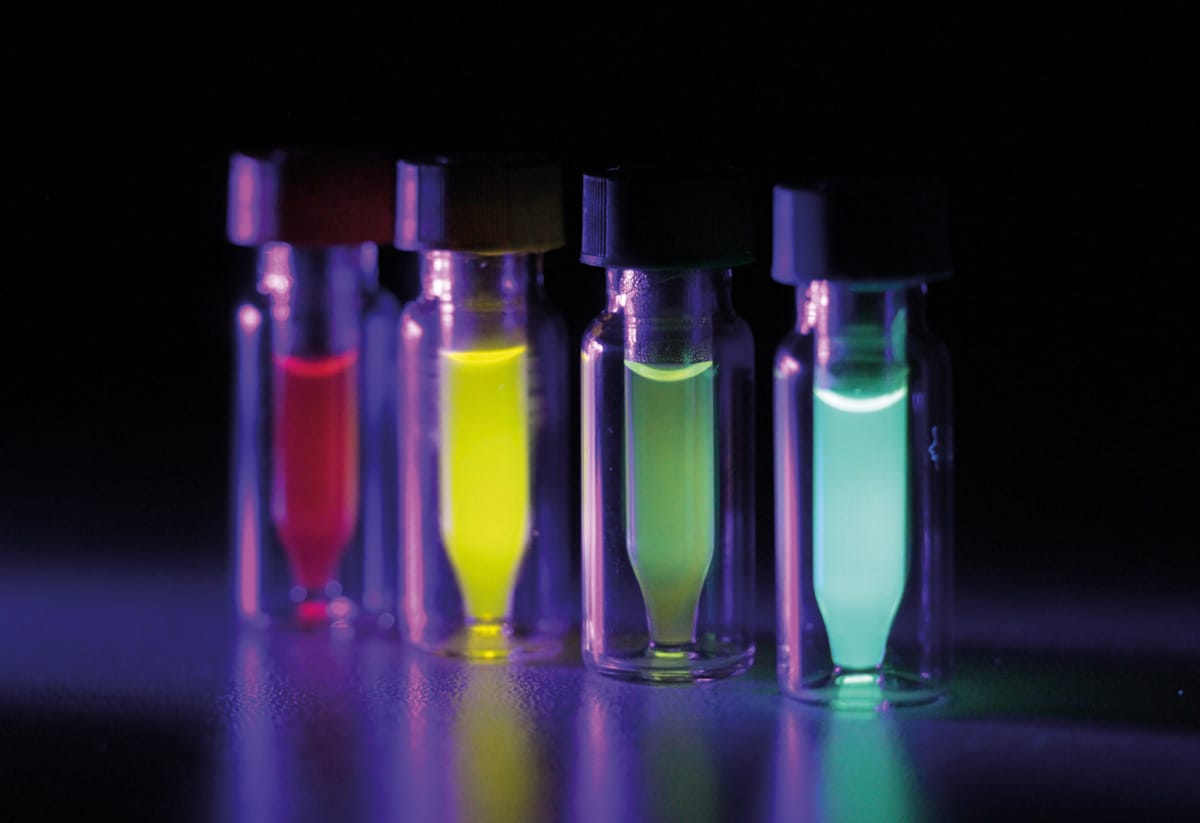Andy Chaloner and Steve Self describe how their company Stream Bio, which manufactures fluorescent nanoparticles for bioimaging applications, refined its products and business model to suit the market

How did Stream Bio get started?
Andy Chaloner, chief executive: We are a little bit of an anomaly as start-ups or spin-outs go, because my partner Michelle Waterfall and I had wanted to start a life-science-based-company for a while, but neither of us are bench scientists. Michelle is a surgeon practitioner by training and I dropped out of a science degree years ago, joined the Navy as an officer and flew helicopters, so my experience is on the project management and logistics side.
We began by doing an intellectual-property trawl, assessing various technologies to see what we could license with a view to making a viable company. We had a good relationship with King’s College London thanks to another project, so we evaluated about a dozen of its technologies. We then narrowed them down to a shortlist, and met the academic inventors – including Mark Green, who is now our director of research.
Mark was originally a quantum dot scientist, but when people started using quantum dots as fluorescent markers in biological cells, he thought, “Hang on, those things are toxic; they’re cadmium-based.” That’s when he started messing around with other materials, including a class of polymers that were originally designed for organic light-emitting diode (OLED) TVs and display screens.
As it turns out, these conjugated polymer nanoparticles (CPNs) are considerably brighter and more stable than anything else used in cell imaging and labelling. Other fluorophore agents, such as the widely used Alexa Fluor® family of dyes, fade after a couple of hours, while quantum dots suffer from blinking effects as well as toxicity. In contrast, CPNs are non-toxic, 1000 times brighter than Alexa dyes, and offer greater photothermal and chemical stability. It’s a real platform technology, and when we were talking to Mark we realized that it has many potential applications. For example, there are research applications for lab scientists doing things like ELISA (Enzyme-Linked ImmunSorbent Assay), Western blotting and flow cytometry. But, there are also applications in diagnosing diseases such as hepatitis C and sepsis, and in therapeutics for tumour imaging or drug delivery.
How did you choose which applications to pursue?
AC: The versatility of these nanoparticles is a massive attraction, but it’s also a slight drawback for us as a company because we had to decide where to start. Our first thought was to use CPNs for tumour imaging – you could do multi-modal imaging with MRI alongside these fluorescent markers. However, when we presented the idea to venture capitalists (VCs), they said it had great potential, but they couldn’t define their exit strategy. They wanted more data. That’s when we flipped the business model and went back to the research market, where you don’t need a clinical trial or a CE mark to get started. That avoids a lot of expense and meant we could get a product to market relatively quickly.
Who else did you bring in to help you?
AC: Initially there were four of us: myself, Michelle, our director of therapeutics David Howat and our chair Peter Brown. After we negotiated a license agreement with King’s, Mark came on board, and we brought in a molecular biologist, Dermot O’Callaghan, to strengthen the link between the technology and its biological applications. Peter also introduced us to Steve Self, who became our commercial director.

Steve Self: I’ve worked with various pharma companies in commercial and R&D roles, and when Peter asked if I would like to become involved in Stream Bio, I enthusiastically said yes. I have a particular interest in nanoparticles, and the reason I like this area is because I think there is an enormous amount of potential in these types of nanoparticle technologies, but they’ve been underexploited. There have been some technological issues, which are now being solved, and the particles themselves are becoming more targeted. Their potential in therapeutics has gone up exponentially, and I think we’re going to see that continue over the next decades as the technology improves even further.
You mentioned approaching VCs and not having much success. How did you get funding?
AC: At the moment we’re still self-funded; we’re just moving into the early stages of generating revenue. However, we’ve had a lot of support from the Centre for Process Innovation (CPI) at NETPark, which is near Sedgefield, UK, and from the European Regional Development Fund (ERDF). That support has helped us to establish an industrial manufacturing process that can produce the nanoparticles in the quantities we need, with the correct sizes and stability, and with all the quality control and assurance you need for a commercial operation. If we’d had to build our own facilities, employ our own staff and buy all our own equipment, it would have meant between half and three quarters of a million pounds of capital investment, versus about £150 000 in ERDF money at CPI.
SS: In the longer term, as we move into the areas of diagnostics and therapeutics, we will need a facility that complies with regulations on good manufacturing practices for pharmaceuticals. But the transition from manufacturing that had been done at a “bench and beaker” level in an academic lab up to an industrial scale is already crucial for a technology like this.
Aside from obtaining funding and developing industrial-scale processes, what’s been your biggest challenge?
SS: We’re entering a competitive market with some very big players. When you do that, you have to work out what’s going to change a buyer’s behaviour – what’s going to make them move away from the existing products that Andy mentioned and choose our particles instead. We’re refining our commercial message constantly to communicate why people should consider using our particles rather than alternatives.
AC: People have known about the problems with the incumbent dyes for so long that scientists have learned to work with them. We can overcome a lot of those problems with our CPNs, but first we have to convince people that they really are as good as we say they are. When I tell potential customers that Alexa dyes last for a couple of hours, but we’ve got a marker that lasts for more than 12 months and is a thousand times brighter, they look at me as if I’m a bit silly. They can’t quite believe it. I’m not saying that Alexa dyes are bad – there are some applications where they work quite well – but there are other areas where our product would be a lot better.
What do you hope to do next with Stream Bio?
AC: Generate revenue!
SS: Good answer, Andy. We set up our first distributor in October 2018, and we now have distributors in the UK, France, Germany, Spain, Portugal and Italy. As 2019 progresses we want to bed in those relationships and refine our marketing message. The next great area is the US. We’ve just received our first purchase order from there.
AC: Earlier in 2019 we also received a loan via the UK’s Innovate Loans competition, which is a pilot project that the UK government started in 2018 as part of its industrial strategy. The rates on these loans are better than you can get at a bank, and they’re designed for what they term “higher risk” companies that can’t get funding for late-stage R&D projects elsewhere. This funding will allow us to develop CPNs that fluoresce at different wavelengths, add new surface chemistries and optimize the size of our nanoparticles. Scientists want choice, and we’re looking to increase our portfolio by three- or four-fold by the end of 2019.
What do you know now that you wish you’d known when you started?
AC: Hindsight is always brilliant and always perfect. If you look at where we are today – making consumable products for R&D customers, with no CE mark or clinical trials and an easy route to market – you could say that it’s a good business model. But it’s almost like we got to that point by bouncing down a cone: we explored one route, it didn’t work, so we came back the other way, and so forth. If we’d adopted that model from the word “go”, that might have saved us a bit of time. Then again, it might not. We had an awful lot of learning experiences along the way.
SS: I would have liked to have known much more about the market structure. When I was in pharmaceuticals there was a lot of information available about what was being sold where and in what strength, but it’s much harder to obtain that information in this field.
What advice would you give to someone who’s starting a company in nanomaterials?
AC: Never give up, and if someone says you can’t do it, ignore them.
- Enjoy the rest of the 2019 Physics World Focus on Nanotechnology & Nanomaterials in our digital magazine or via the Physics World app for any iOS or Android smartphone or tablet.



